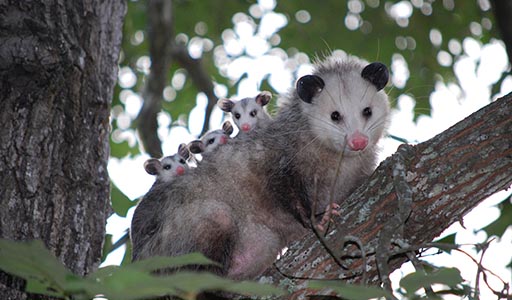Opossum Removal
Do you need to get rid of oppossums? We can help!

Opossum Removal Strategies
Opossum Problem

Signs a Opossum is on Your Property
Opossums are small grey mammals with a white face and long snout. Opossums habitat wooded areas and will seek natural shelter in abandoned trees and logs. When opossums are threatened, they will “play possum,” mimicking the appearance of a dead animal by laying on the ground with an open mouth. In this position, opossums are protected from any potential predators. Opossums are nocturnal animals, meaning that they are most active during the night. And, although they do not hibernate, opossums are less active during the winter months.

Dangers of Opossum Infestation
Opossums and other small mammals make meals out of honey bees, which is problematic for beekeepers and negatively affects pollination efforts. Gardens also offer convenient meals and suffer from opossum foraging. Their feces and urine contaminate water and food sources. Finally, opossums are known to carry tuberculosis, tularemia, and Chagas disease, and serve as hosts for fleas. Any bites or scratches received from the animals should be treated immediately by medical professionals.
Humane Opossum Removal & Control Strategies

Entry into property
The space beneath porches, decks, and stairs all serve as ideal nesting locations for opossums. If they can find entry, they will also inhabit areas within buildings, such as attics and garages. Since opossums are nocturnal, humans are often unaware of their presence until their foraging behavior becomes a problem. In their search for food, the marsupials may leave behind trash debris and fecal deposits. They even damage property in the way of potential food.

Trapping & Removal
Safety is the number one priority, so inexperienced individuals should seek professional removal assistance when opossums become problematic. Tructech wildlife specialists operate with up-to-date equipment and have extensive knowledge of opossum behavior. Taking an integrated pest management approach, our staff can assist in wild animal removal.

Prevention & Exclusion
To prevent opossums from taking up residence under decks and building foundations, property owners should seal any holes with caulk or wire mesh strong enough to withstand animal disturbances. Also, access to potential food sources should be limited. Individuals can achieve this by sealing trash bins with fitted lids and keeping pet and livestock food in secured locations.
Frequently Asked Questions
Despite their harmless reputation, opossums carry a multitude of diseases that can be passed to people. Some of the more serious include leptospirosis, tuberculosis, relapsing fever, tularemia, spotted fever, and Chagas disease.
In addition, an opossum hosts a number of parasites in its fur, such as fleas, ticks, mites, and lice. These infestations can cause further problems for people, homes, and pets.
The sheltered, dry environment provided by attics attracts opossums. Residents of homes with opossums in attics may be alerted to the pests’ presence by scratching, clawing, and rustling noises. As opossums are nocturnal, people are most likely to hear these sounds at night. Additionally, homeowners may smell or see accumulations of droppings. Opossums also leave behind tracks around the exterior of homes, along deck railings, downspouts, tree trunks, and other structures used to gain rooftop access.
Property owners can limit opossums’ access to attics by sealing all openings in walls and roofs. Employing chimney traps and installing metal or plastic spikes on downspouts also helps deter the pests. To restrict their ability to obtain food, residents should also secure garbage cans with tightly fitting lids and keep pet food indoors at night.
Opossums are typically quite happy outside. However, the temptation of warm, sheltered houses full of food is sometimes too great to resist. Although the nocturnal pests are slow on their feet, they are excellent climbers and use this skill to reach open attic windows. Opossums are also proficient diggers that can burrow their way inside homes. The pests are about the size of an average house cat and will come inside through pet doors if they are feeling bold.
To prevent the presence of opossums in the house, property owners should enclose areas under decks and patios with mesh wire, as these are popular denning sites. Bring outdoor pet food inside overnight and secure garbage bins with tightly fitting lids to take away easy access to food sources. Securely fasten attic windows and seal gaps in exterior walls. Trimming back overhanging tree branches will also make it harder for opossums to access roofs and attics.
Since opossums are nocturnal, their presence in yards is not always readily apparent. Property owners must lookout for signs of the destruction they cause in order to catch opossum infestations early. Missing pet food, knocked over garbage cans, and holes under decks or porches point to the existence of opossum problems.
Other signs include finding tracks, scat, and seeing or hearing the pest as it moves about from one den site to another. Opossums also dig up sod and gardens in search of easy insect meals, although this kind of behavior is more commonly attributed to raccoons and skunks.
Toggle Opossums, like most other pest mammals, seek shelter under porches, decks, and homes to gain protection from the elements and predators. Small openings in porch and deck siding as well as holes in building foundations grant the pests access to these spaces. Since residential areas often provide plentiful food and water, opossums are highly motivated to set up dens on private properties and will use their sharp claws to force entry if necessary.


